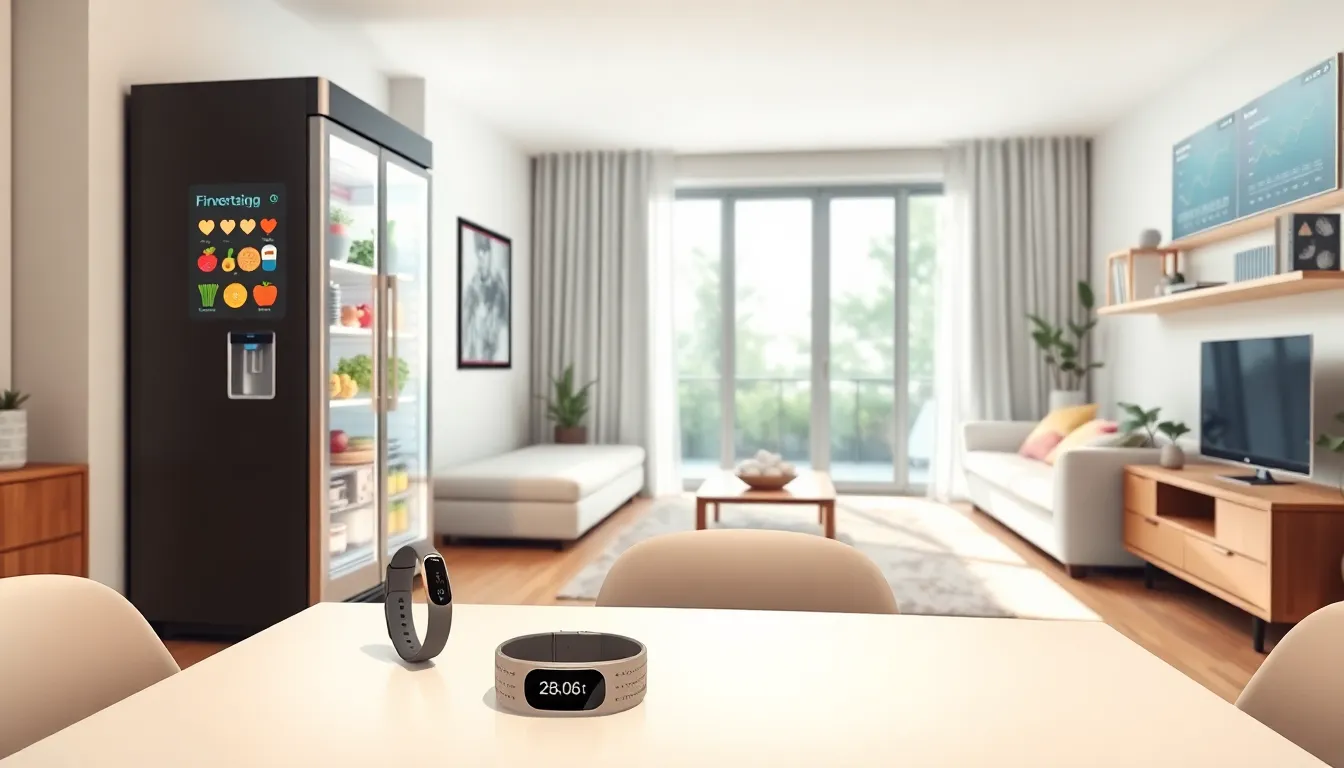In a world where your toaster might just be smarter than you, big data and the Internet of Things (IoT) are shaking things up like never before. Imagine a universe where your fridge knows when you’re out of milk and your car can schedule its own oil change. Sounds like sci-fi? It’s reality, and it’s happening now.
Big data isn’t just a buzzword; it’s the secret sauce that fuels the IoT engine, turning ordinary devices into extraordinary data-gathering machines. With every click, swipe, and beep, these gadgets collect insights that can transform industries and everyday life. So buckle up as we dive into this tech wonderland where data reigns supreme and your devices are more connected than ever.
Table of Contents
ToggleUnderstanding Big Data and The Internet of Things
Big data constitutes vast volumes of structured and unstructured data generated every second. Organizations utilize advanced analytics to extract actionable insights from this wealth of information. The Internet of Things connects smart devices to the internet, allowing seamless communication and data sharing among them.
Smart devices, equipped with sensors, collect real-time data about their environments. For example, fitness trackers monitor users’ activities, while smart thermostats learn user preferences to optimize energy consumption. This data continuously flows to cloud servers, where algorithms analyze patterns and trends.
A significant advantage of big data in IoT lies in predictive analytics. Businesses predict equipment failures and optimize maintenance schedules through analysis of historical and real-time data. This proactive approach reduces downtime and operational costs, enhancing overall efficiency.
Interconnected technologies enhance various sectors, including healthcare and transportation. In healthcare, wearables gather patient data, enabling remote monitoring and timely interventions. In transportation, vehicles communicate traffic patterns, improving navigation and reducing congestion.
Security concerns also accompany the integration of big data and IoT. Data breaches can expose sensitive information, prompting the need for robust security measures. Encryption and authentication protocols safeguard data integrity and privacy.
With the expanding landscape of IoT devices, the volume of data generated is set to increase exponentially. This growth presents both challenges and opportunities for organizations aiming to leverage insights for competitive advantages. Investing in infrastructure that supports big data analytics remains crucial for businesses eager to harness the power of this interconnected ecosystem.
The Relationship Between Big Data and The Internet of Things

Big data and the Internet of Things (IoT) work together to enhance how devices interact and operate. Through this synergy, vast amounts of data are generated and processed, driving innovation across various sectors.
Data Collection
Data collection forms the foundation of the relationship between big data and IoT. Smart devices equipped with sensors continuously gather real-time information. For instance, smart refrigerators monitor food inventory levels while fitness trackers track user activity. This information flows into centralized databases, allowing organizations to accumulate extensive data sets. The more devices connect to the internet, the more data they generate. Each device contributes unique data points, enriching the overall dataset and providing a comprehensive view of user behavior, preferences, and operational efficiencies.
Data Analysis
Data analysis is where the real value of big data and IoT emerges. Analyzing the collected information reveals actionable insights that organizations can leverage. Predictive analytics uses historical data to foresee trends and potential issues, minimizing equipment downtime and enhancing planning. For example, healthcare providers utilize wearables to analyze patient health data, enabling timely interventions. Meanwhile, transportation networks optimize routes by analyzing traffic data in real-time. With advanced algorithms and machine learning techniques, organizations uncover patterns that drive informed decision-making and promote efficiency across sectors.
Applications of Big Data and The Internet of Things
Big data and the Internet of Things create impactful applications that enhance everyday life. They transform various sectors, including smart homes and healthcare.
Smart Homes
Smart home devices integrate IoT technology to create seamless living experiences. Energy-efficient systems monitor usage and adjust settings automatically, leading to significant savings. Home security systems utilize sensors to detect motion, providing real-time alerts to homeowners. Voice-activated assistants streamline daily tasks by controlling various appliances, enhancing convenience. Enhanced data analytics helps identify usage patterns and suggests improvements, optimizing functionality.
Healthcare Innovations
Healthcare benefits immensely from advancements in big data and IoT. Wearable devices track patient vitals, enabling continuous monitoring outside traditional clinical settings. This data allows healthcare providers to make informed decisions based on real-time information. Telemedicine applications leverage connectivity to improve access to care, especially in remote areas. Predictive analytics identifies potential health issues early, facilitating timely interventions. Enhanced patient engagement results from the availability of data-driven insights, empowering individuals to manage their health proactively.
Challenges in Integrating Big Data and The Internet of Things
Integrating big data with the Internet of Things presents several challenges that organizations must navigate for success. Addressing these challenges effectively can lead to improved operations and enhanced insights.
Data Privacy Concerns
Data privacy emerges as a significant issue when integrating big data and IoT. As smart devices collect sensitive information, the risk of data breaches increases. Failure to protect this data can lead to significant consequences, such as loss of customer trust and legal repercussions. Regulations, like the General Data Protection Regulation (GDPR), impose strict guidelines on how organizations manage personal data. Companies must, therefore, implement robust security measures such as encryption and advanced authentication protocols. Ensuring compliance with these regulations not only protects user information but also fosters a secure environment for data sharing and collection.
Infrastructure Requirements
Infrastructure requirements are critical for successful integration. A robust technological foundation supports the seamless interaction between big data and IoT devices. Organizations must invest in scalable storage solutions and high-speed networks to handle the vast amounts of data generated. Additionally, cloud computing often provides the necessary flexibility and scalability for processing this data efficiently. It is essential for businesses to focus on implementing high-performance computing capabilities that can analyze large data sets in real time. Integrating these infrastructure components effectively enables organizations to harness the full potential of big data and IoT.
Future Trends in Big Data and The Internet of Things
Predictive analytics is set to become more sophisticated as machine learning algorithms advance. Organizations increasingly rely on these algorithms to analyze vast datasets generated by IoT devices. Enhanced accuracy in predicting equipment failures leads to more efficient maintenance processes.
In healthcare, the synergy between big data and IoT is likely to drive personalized medicine. Wearable devices continuously collect health metrics, allowing for tailored treatment plans based on individual data. This personalization enhances patient outcomes and optimizes resource allocation.
Smart cities will emerge as another significant trend. Sensors integrated into urban infrastructure collect data on traffic patterns, air quality, and energy consumption. This information helps city planners optimize public services and improve residents’ quality of life.
Security remains a top priority in the future landscape of big data and IoT. Organizations are expected to adopt stricter security protocols to protect sensitive information. As the number of devices expands, enhancing encryption and authentication methods will be essential in combating potential threats.
Real-time data processing capabilities will gain importance as organizations strive for swift decision-making. Big data analytics platforms will increasingly support rapid data ingestion and analysis. This capability allows businesses to respond to customer needs and market changes in real time.
Sustainability initiatives are also likely to benefit from the integration of big data and IoT. Businesses can monitor resource usage and minimize waste through data-driven insights. These efforts contribute to environmentally conscious practices across various sectors.
Lastly, enhanced data governance will play a critical role in managing privacy concerns. Addressing regulations like GDPR becomes vital as data collection increases. Organizations will prioritize transparency, ensuring user trust remains intact while leveraging insights for growth.
The fusion of big data and the Internet of Things is reshaping industries and everyday experiences. As smart devices become more autonomous and data-driven, their potential to enhance efficiency and connectivity continues to grow. This interconnected landscape not only improves operational capabilities but also empowers individuals through real-time insights.
While the benefits are significant, organizations must remain vigilant about security and privacy concerns. Investing in robust infrastructure and adopting strict data governance practices will be essential for navigating these challenges. Looking ahead, the ongoing evolution of big data and IoT promises exciting advancements that will further transform daily life and business operations. Embracing these technologies will be crucial for staying competitive in an increasingly data-centric world.






